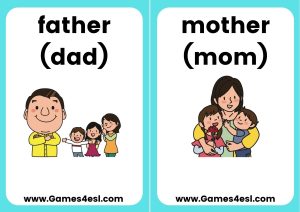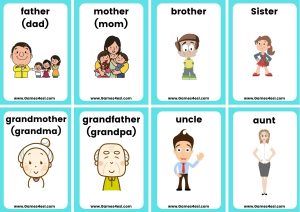Lesson Plans and Activities in Telling Our Family Story Pdf

This family lesson plan is great for didactics kids and beginner English language linguistic communication learners about the members of the family unit in English. Learning vocabulary and expressions virtually family and family members is essential for ESL learners, both immature and old. Everyone has relatives and so this topic is something everyone can relate to. Learning to talk about families connects students' real life experiences with what they learn in the classroom, which is great for language learning.
On this folio you can notice complete ESL lesson plan most family and family members. This lesson program includes all the materials you demand including PDF flashcards, student cards and board games. The games and activities on this page will have your students talking well-nigh their families in no time.
This lesson program is mainly aimed at kids / beginner learners of English. See the below to download all the materials needed for this lesson. In addition, at the bottom of this page you tin can find boosted materials to teach about family members to ESL learners.
Materials for this lesson:
- Flashcards – Family unit
- Student Cards – Family
Family unit Lesson Plan
Introduce the Topic, Keywords and Expression

Before education the key words for the lesson, information technology is important to put the lesson into context and then that students understand what they will learn. This will also activate the students existing noesis about family vocabulary.
The easiest way to contextualize a lesson most family is to show students pictures of your family unit. Showing your family unit will likely be very interesting to your students, especially if y'all teach young learners. Evidence students pictures of your family and enquire them to guess who they are. For instance, show them a flick of your brother / sister and ask them to guess how they are related to y'all.
This tin can atomic number 82 to some funny answers, particularly with kids every bit they don't always accept a great concept of age. In many of my classes over the years, kids unremarkably gauge that my older blood brother is my dad, and my dad is my grandfather.
Adjacent, do the fundamental words for the lesson using thesefamily unit member flashcards. Testify students the flashcard i by one and enquire them to repeat after you. Then, show students again and ask them to say the words on their own.
In one case students have practiced several times, information technology's time to introduce the key expressions you will utilise during the lesson. The key expressions you employ will depend on the age and level of your students, and your particular curriculum. Hither are a few instance sentences you tin employ while pedagogy a lesson on family:
- Who'southward this/that? – This is my (father).
- Who's he/she – He/She is my (brother/sister).
- What does your begetter/female parent do? – He/She is a (pilot).
- How many brothers and sisters exercise you accept? – I have 2 brothers and i sister.
Activeness 1: Nice To Encounter You Game
After introducing the key words and expressions, information technology's time for a fun game to exercise some more. This activeness involves the whole class and requires a set offamily flashcards.
How To Play:
Place thefamily flashcards on the board in a horizontal line. Then separate the course into two teams. Next, the 2 teams should line upwards at reverse ends of the line of flashcards. Ane pupil from each team should motility down the line towards each other, touching each flashcard and saying the key sentence as they go. For example, 'This is my father.', 'This is my mother.', and so on. When they run into, they should stop and have a dialogue using the key expressions. For case,
Educatee A: 'Who's this?'
Student B:'This is my father.'
Student A: 'Overnice to meet you.'
Once students have completed the dialogue they should play Stone, Pair of scissors, Paper. The winner stays where he/she is. The loser goes to the back of their team's line and the side by side educatee from that team gets ready. When the instructor says 'Get', the students walk towards each other downward the line touching each flashcard and maxim the fundamental expression once more.
When they meet, they accept a dialogue, play Rock, Scissors, Paper, and and then on. The aim of the game is to reach the other stop of the line of flashcards. If they make information technology all the way to the other side, they get a betoken for their team.
Action two: Guessing Game – Speaking Practice

This game tin be played in pairs or small groups of 3/4. For this activity each group needs a set of smaller flashcards. Download, print, and cutting out thesefamily student cards and give one gear up to each group.
How To Play:
Each group should identify their 8 cards face up downwards and mix them up. Students will have turns guessing the family fellow member while using the target linguistic communication. To practise this, one educatee will point to a menu and ask another student 'Who's this?'. Then that educatee will try to approximate who information technology is by saying, 'This is my (mother).'
Then they should turn the card over to see if he/she guessed correctly. If they got information technology right, then that pupil gets to go along that bill of fare. If he/she got it incorrect, then they plow the menu over once more and mix up the cards. The game finishes when all the cards have gone and the student with the most cards is the winner.
Activeness 3: Level Upwardly Game

This fun speaking game will get students up out of their seats and talking with their classmates. For this action, again you demand thefamily unit student cards. You can re-use the cards from the previous activity. This activity is also explained inthis video from Games4esl.
How To Play:
In this activity, each student needs 1 family member student card. Next, explain that the 4 corners of the classroom are four different levels. Level 1, Level 2, Level three, and Level 4. First, all students should starting time at level i. There, they should meet another student and take a dialogue based on the family member that is on their card. For instance,
Student A: Who's that?
Student B: This is my uncle. Who's that?
Student A: This is my sister.
Side by side, the ii students should play Rock, Scissors, Paper. The winner and so moves to Level two, and the loser stays at Level ane. And so students should run across some other classmate at their level and have a dialogue. So play Rock, Pair of scissors, Paper, and then advance to the adjacent level or stay where they are.
Students should continue this until they take fabricated information technology to Level four. In one case students have advanced through all iv levels, then they get a sticker ( or high five from the teacher, etc) and start again at level one. Later on near 5 minutes, the student with the most stickers / points is the winner.
Review – Family Tree Diagram
At the finish of the lesson, review the primal words and expressions from the lesson. A dandy manner to review what they have learned, and to cheque their understanding of family vocabulary, is to ask students to help y'all to complete a family tree diagram.
Beginning at the top of the board and draw / write 'grandpa'. Elicit the other family unit members from students equally you draw out a family tree. Once the family unit tree is complete, you tin review the key expressions from the lesson. For example, ask students 'Who's this?', and students can answer 'This is my brother,', etc.
More Activities And Games to Family to Beginner ESL Students
- Family Worksheets
- Family PPT
- Family Flashcards
- Family Vocabulary Exercises
southernpothead1969.blogspot.com
Source: https://games4esl.com/lesson-plans/family/
Post a Comment for "Lesson Plans and Activities in Telling Our Family Story Pdf"